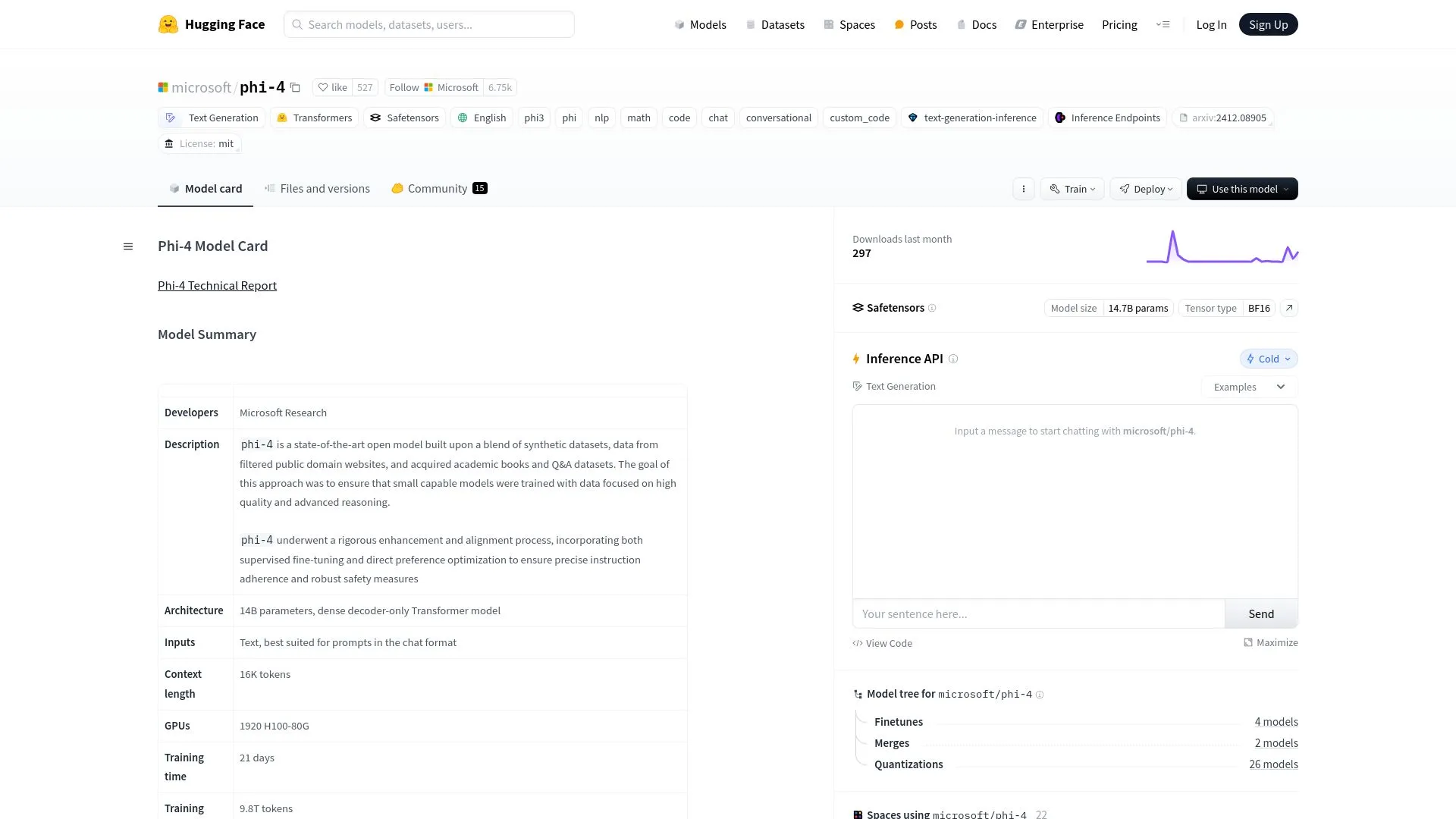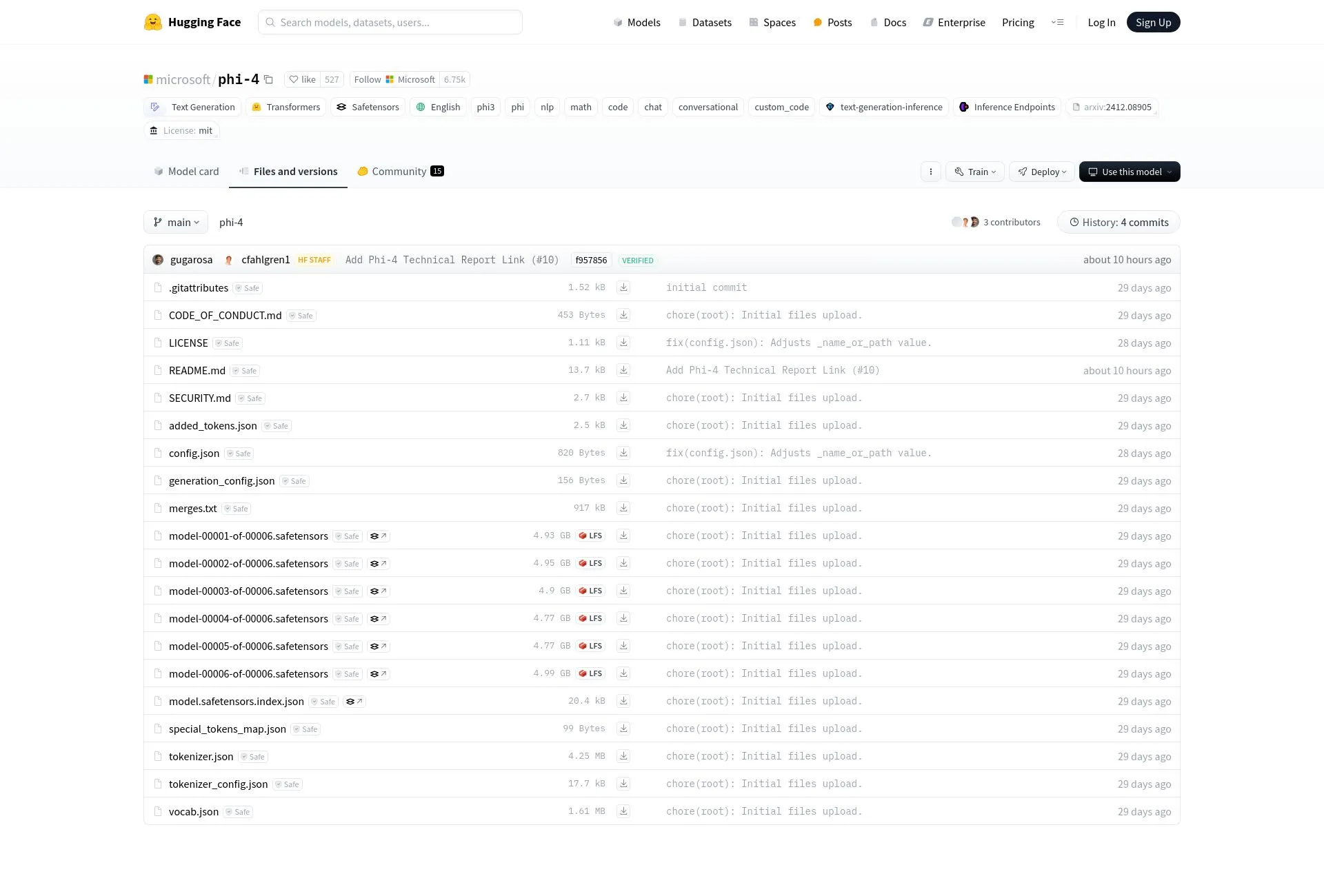
Microsoft Phi-4 Highlights
Power
14B parameters with dense decoder-only Transformer architecture for enhanced reasoning capabilities.
Scale
Processes up to 16K tokens with 9.8 trillion training tokens from high-quality sources.
Safety
Comprehensive post-training safety alignment measures to enhance reliability and mitigate risks.
Speed
Optimized for low-latency scenarios, delivering quick responses for real-time applications.
Introduction to Microsoft Phi-4
Are you facing challenges with generative AI functionality, particularly in enhancing reasoning and logic tasks? Whether you’re involved in memory-constrained environments, latency-bound scenarios, or require advanced language processing, Microsoft Phi-4 might be the solution you need. This state-of-the-art AI tool is engineered to tackle specific pain points encountered in various applications, from academic research to real-time applications. How can a model with 14 billion parameters transform your workflows and empower your projects? Let’s explore how Microsoft Phi-4 can address these critical needs and enhance your AI experience.
Key Features and Benefits of Microsoft Phi-4
- 14B Parameters: A dense decoder-only Transformer model built for improved reasoning capabilities.
- Context Length: Supports up to 16K tokens, allowing for extensive data inputs in a single interaction.
- Training Data: Utilizes a vast dataset of 9.8 trillion tokens sourced from high-quality documents.
- Post-Training Safety Alignment: Includes comprehensive measures to enhance safety and mitigate risks.
- Robust Benchmark Performance: Outperforms various models across multiple established benchmarks.
5 Tips to Maximize Your Use of Microsoft Phi-4
- Utilize the model in low-latency scenarios to benefit from quick responses.
- Leverage its wide context capabilities for complex tasks that require thorough inputs.
- Explore multilingual sources for diverse applications, capitalizing on its varied training data.
- Regularly evaluate model outputs to ensure alignment with your specific use cases for better outcomes.
- Engage in collaborative projects where shared knowledge can enhance the AI’s effectiveness.
How Microsoft Phi-4 Works
Microsoft Phi-4 is built on a cutting-edge Transformer architecture with a focus on generative AI tasks. By employing a dense decoder-only structure, it processes information efficiently to deliver contextually relevant responses. The model engages with an extensive training corpus composed of both real and synthetic data, allowing it to develop a robust understanding of language and reasoning. Its ability to analyze large inputs is especially beneficial in environments that require comprehensive data assessment and quick outputs.
Real-World Applications of Microsoft Phi-4
This model finds efficacy across various sectors, including:
- Education: Assisting in the creation of intelligent tutoring systems and educational content generation.
- Research: Enhancing data analysis and summarization in academic settings.
- Customer Service: Driven chatbots that provide effective and contextually aware customer support.
- Software Development: Aiding in code completion and bug detection for programming tasks.
Challenges Solved by Microsoft Phi-4
Microsoft Phi-4 addresses several challenges faced by users:
- Limited AI capabilities: Enhances reasoning and logical tasks.
- High-latency requests: Optimized for quick responses suitable for real-time applications.
- Quality of outputs: Filters out low-quality data to improve overall model performance.
- Bias and safety concerns: Implements a thorough post-training alignment process to mitigate risks.
Ideal Users of Microsoft Phi-4
The primary users of Microsoft Phi-4 include:
- Researchers looking to push boundaries in natural language processing.
- Educators aiming to develop advanced learning tools.
- Corporate teams focusing on customer engagement and service improvement.
- Developers interested in integrating intelligent solutions into their applications.
What Sets Microsoft Phi-4 Apart
Three unique qualities that distinguish Microsoft Phi-4 from its competitors include:
- Enhanced reasoning capabilities: Significantly improves performance on logical and analytical tasks.
- Robust training dataset: A well-curated data source leading to higher quality outputs.
- Proactive safety measures: A comprehensive approach to align model outputs with user safety expectations.
Improving Work-Life Balance with Microsoft Phi-4
Microsoft Phi-4 can significantly enhance work-life balance by automating repetitive tasks and providing smart solutions that free up valuable time for users. Whether you’re generating reports, drafting content, or facilitating communication, Phi-4’s sophisticated capabilities allow professionals to focus on higher-level strategic initiatives. By integrating this AI tool into daily workflows, users can achieve greater efficiency and productivity, ultimately leading to a more balanced work-life dynamic.




